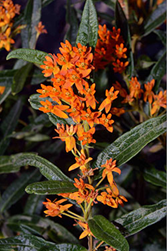A Cutting Garden Reimagined
- 2024-03-02
- By mkirk
- Posted in Horticulture, The Garden Buzz
By Caitlin Tongco, Colorado Master Gardener

Consider this. While out grocery shopping, you go to the floral section and bring home a bouquet of sunflowers, carnations and baby’s breath. The boisterous yellows and reds, the smell and the overall appearance of the bouquet is attractive. It looks gorgeous on your kitchen counter, but then you look out the window at perennials in your front garden bed and think: “Could any of those plants create a home-grown arrangement? Surely this would be more sustainable, whimsical and fun.” The hard truth is that the domestic flower industry is not sustainable. Pesticide and chemical use in the floral industry is unregulated, plastic waste is a problem, and a majority of cut flowers are imported, resulting in a large carbon footprint.
The good news is that you can create and enjoy a beautiful bouquet at home with flowers from your own cutting garden.
Because the growing season along the Colorado Front Range is short and often fraught with unpredictable weather, native and low-water plants are good choices for cutting gardens since they are more apt to survive severe weather. These plants also serve multiple functions. In urban areas they can add food, shelter, and other important resources for wildlife while also supporting native habitat.
Blue Flax, Blazing Star Liatris, and Silver Lupine are all beautiful supportive flowers in a cut arrangement. While they are not stealing the show, their deep blues (sometimes almost iridescent silver) and bright purples add depth and visual interest. Our state flower, the blue Columbine, can also be a terrific addition to the garden for pollinators and for any flower arrangement. Varieties of sages and grasses, like Blue Grama grass, can add texture to the garden and be fillers in cut flower arrangements.

A good floral arrangement is like a well-organized garden. The structure of an arrangement relies on multiple varying components to make it more visually appealing. Like the design of a garden, a cut arrangement should include structural plants, focal flora, supporting flowers, and a combination of filler, texture or airy plants. The contrast of texture creates a visually interesting and engaging piece suitable for display. In addition to those components, there are some good guidelines to follow: Create visual interest with odd numbers and groupings of plant material. The selected colors can reflect your preferences but try to stick to either a similar palette or, if contrasting, use no more than three colors. Lastly, arrangements with a linear form create interest.
In the later summer months, the garden abounds with warmer hues – the bright yellows, radiant reds, and fiery oranges all flourish under the intense sun. Those warmer temperatures and colors tend to result in a warmer hued bouquet. You can achieve the typical sunny sunflower bouquet with a close family relative, Black-eyed Susan (Rudbeckia hirta). It is a stunning deep yellow flower that is native to Colorado. Prairie Coneflowers, with their long, conical center and blood red or golden petals, are also an eye-catcher. Milkweed is also a common pollinator plant that can be a wonderful filler in any arrangement; however please handle this plant carefully as it may cause some skin irritation.

Not every flower makes a good cut flower. Some have a short vase life, while others may not continue to bloom after harvest. Here are some tips and tricks to elongate vase life:
- Cut your flowers in the cooler part of the day and immediately place them into a bucket of cool water.
- Remove excess greenery from plant stalks prior to placing in the vase.
- Cut stems at a forty-five degree angle while trimming.
- Note: lilac flowers, while not native but well-adapted to the Front Range, do not continue to bloom when cut and typically have a short lifespan.
Use the tips above to extend the lifespan of your cut flowers. Enjoy the heavenly scent for longer!
Planning, nurturing and harvesting flowers directly from the garden is not as simple as picking a bouquet up from the grocery store. However, by researching and cultivating a garden that encourages native plants, a gardener is not only creating an environment, but also an environment that is beneficial to our Colorado fauna. Therefore, in the pursuit of something as simple as a floral arrangement, one can create a mutually beneficial bit of beauty for both the kitchen counter and the Front Range.
Horticulture Resources
- Garden Buzz Archives
- CSU Extension Resources
- Colorado Master Gardener Program
- Foothills to Plains Native Plant Master Program
- Native Bee Watch Community Science Program
- The Co-Hort Blog
- PlantTalk Colorado
- Soil Testing
- Plant Select
- Emerald Ash Borer
- Japanese Beetle
- Colorado State Forest Service
- Ask an Expert


